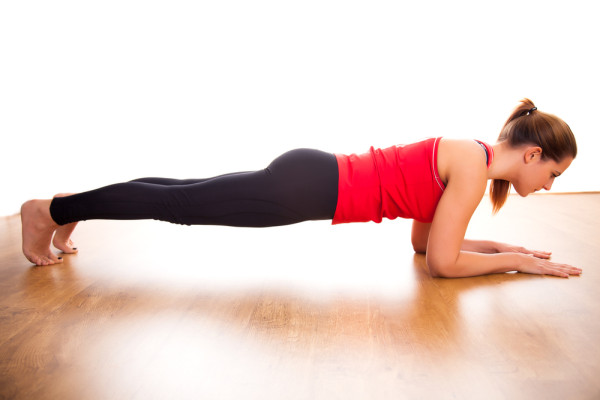
I don’t like crunches. They hurt my neck. No matter how hard I focus on keeping my eyes up and my chin off my chest, I still feel my neck is getting more of a workout than my abs.
That’s why crunches don’t appear often in my (or my clients’) workouts. I don’t ignore the core however. It is the foundation of our body and functional movement. I just choose to train it other ways.
There are plenty of non-crunch techniques to help you develop your core. If you have low back issues or simply don’t want a pain in the neck, try one of these ways to build a strong and stable core.
1. Planks: I love ab holds and high planks, but they can get boring after awhile. Once a client can maintain an ab hold for 60 seconds, I move on to more challenging plank variations. To take your plank to the next level, try one of these.
- Stability ball plank: Place your forearms on a stability ball and toes on the ground. Hold for up to 90 seconds.
- Plank slides: I love Valslides for core work! Place one Valslide under each hand while in high plank position. Alternating pushing arms forward and back, about 6 inches away from your body, for 12 reps per side.
- Body Saw: Take your plank to a new level by keeping your forearms on the ground but place your feet in suspension trainers that are hanging about 10 – 12 inches from the ground. Move forward and back for 10-15 repetitions.
2. Kettlebell Swings: Single arm or alternating arm swings engage your core more than double arm swings. The offload makes your body want to twist so you need to engage your core to keep that kettle bell moving right down the middle. The hinging movement can also help strengthen your low back – an often-overlooked element of your core.
3. Single Leg Exercises: Balance is not just about the stabilizers in the legs, it’s also about stabilizing your core. My two favorite single leg moves are the single leg Romanian deadlift and the single leg bridge. The single leg Romanian deadlift is also a hinging movement, which means it can also be useful in strengthening the low back. The single leg bridge requires core stability to prevent rolling off to one side and makes a great single leg move for beginners. Both exercises also help you build a better backside.
4. Boxing: Punches come from your core and your hips, not your arms. Every jab and cross involves a twist, which works your obliques. You can learn basic boxing moves in quick workouts like Jillian Michaels Kickbox FastFix, one of my favorite DVDs. For extra resistance you can shadow box with dumbbells in your hands or with weighted gloves. Rounds of punching and kicking a bag are also a great way to get low impact but high intensity cardio.
5. Yoga: Of course planks work your core, but so do twists like revolved triangle and holds like warrior two. A good yoga teacher will also help you learn how to engage the right muscles and feel what good posture is. Learning how to brace your core will help you be an all around better exerciser and give you a better chance of remaining injury free. Good posture makes you look taller, leaner and more confident. If you’re like me and a yoga class is too much pressure try learning at home with yoga series from Dailyburn.
How do you feel about crunches? How do you keep a strong core without them?
Also Read:
5 Best Jillian Michaels Workout DVDs
